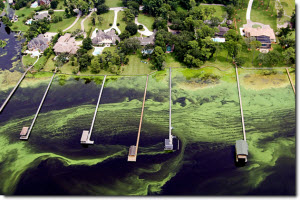The Effects: Dead Zones and Harmful Algal Blooms

Dead zones are areas of water bodies where aquatic life cannot survive because of low oxygen levels. Dead zones are generally caused by significant nutrient pollution, and are primarily a problem for bays, lakes and coastal waters since they receive excess nutrients from upstream sources.
Excess nitrogen and phosphorus cause an overgrowth of algae in a short period of time, also called algae blooms. The overgrowth of algae consumes oxygen and blocks sunlight from underwater plants. When the algae eventually dies, the oxygen in the water is consumed. The lack of oxygen makes it impossible for aquatic life to survive. The largest dead zone in the United States – about 6,500 square miles – is in the Gulf of Mexico and occurs every summer as a result of nutrient pollution from the Mississippi River Basin.
When some types of algae blooms are large and produce chemicals, or toxins, the event is called a harmful algal bloom. Harmful algal blooms can occur in lakes, reservoirs, rivers, ponds, bays and coastal waters, and the toxins they produce can be harmful to human health and aquatic life. Harmful algal blooms are mainly the result of a type of algae called cyanobacteria, also known as blue-green algae.
Elevated nutrient levels and algal blooms can also cause problems in drinking water in communities nearby and upstream from dead zones. Harmful algal blooms release toxins that contaminate drinking water, causing illnesses for animals and humans.
